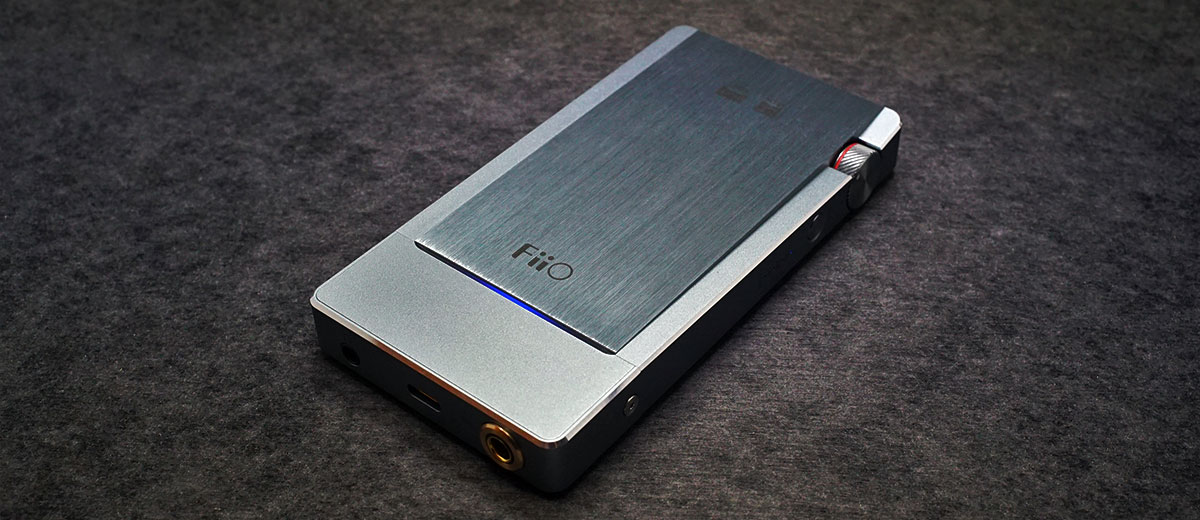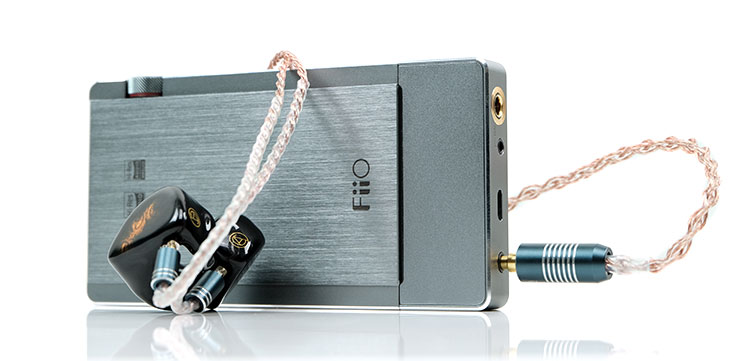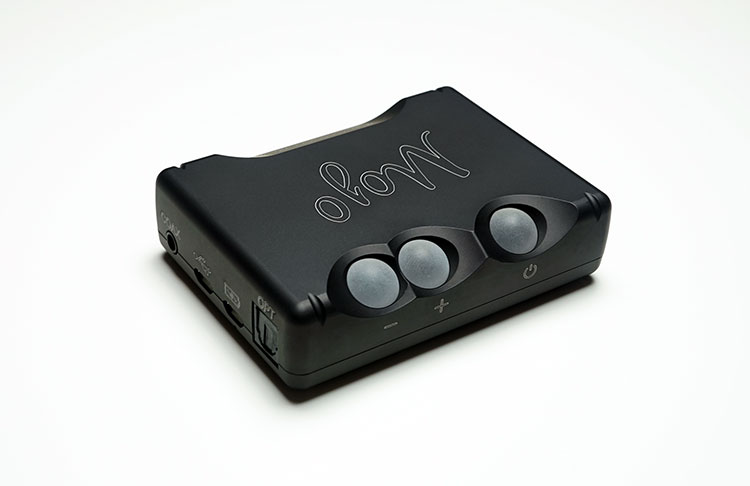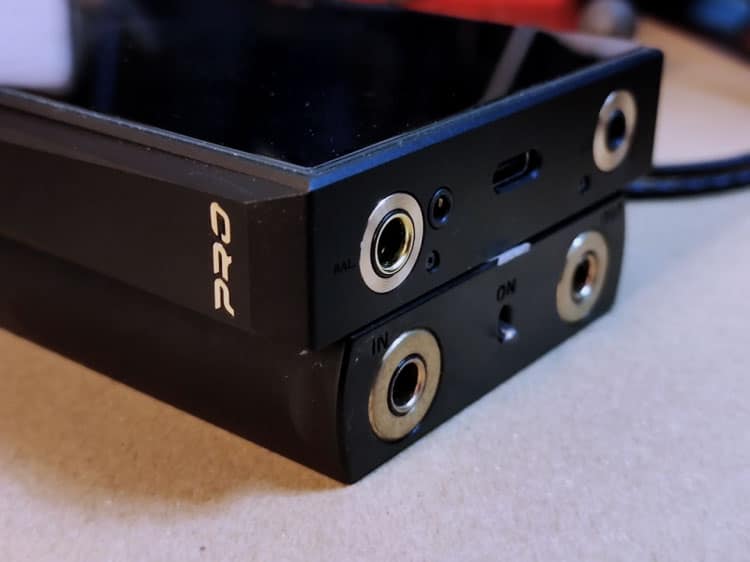The FiiO Q5s Type-C is a portable DAC and amp featuring a detachable THX AAA AM3D amp card, dual AK4493EQ, and Bluetooth. It is priced at $399.99
Disclaimer: The FiiO Q5s Type-C sent to us is a sample in exchange for our honest opinion in this review. We thank FiiO for this opportunity.
To learn more about FiiO reviews on Headfonics you can click here.
Note, this review follows our new scoring guidelines for 2021 which you can read up on here.
The FiiO Q5s Type-C DAC Amp with the THX AAA technology AM3D module is the latest rendition in FiiO’s Q series portable decoder and amplifier.
The series has been one of the strongest portable wireless receivers and the earlier release Q5s received our Best Portable Amp/DAC award for 2018.
Now it strikes again with DSD512 support, USB-C port, new BT5.0 chipsets, and the THX AAA™ 78. This is a THX Achromatic Audio Amplifier design, the world’s first THX Certified standalone amp module with 2 THX AAA-78 chips that are known for their high linearity and low coloration.
The same amplifier design is used on the M11 Pro and Japan limited AM3C module which has gained very high popularity.
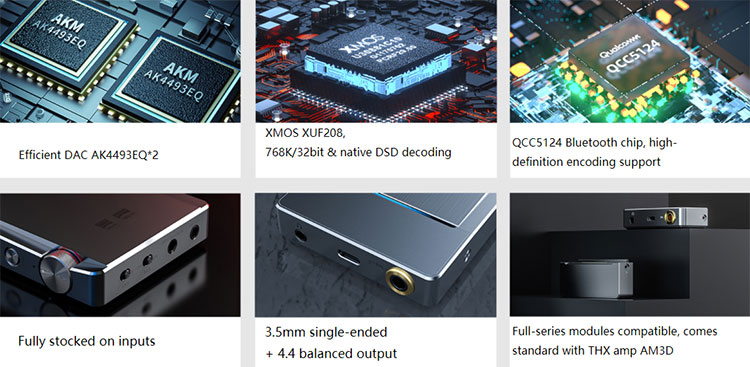
Tech Inside
AM3D THX AAA-78
The well sought after and limited AM3D is part of FiiO’s interchangeable amp card system that has been used on the FiiO X7, X7 Mark II, Q5, and the 2018 Q5s. The latest design comes with a USB-C port upgrade hence the name Q5s Type-C. This will allow you to transfer music, upgrade firmware, or connect to other devices quickly and keep the user experience up to date.
With 32Ω the Amp can output up to 550mW power on Balanced output and achieves >110dB separation. With the line-in analog input, you could use the Q5s Type-C as a pure amplifier bypassing the internal decoding.
Back in Jan 2019 FiiO released 150 sets of the AM3C modules, the first THX interchangeable module in the world, and is limited in the Japanese market. Not surprisingly with a broad user base using the modular system, the 150 sets of AM3C are all sold within the day.
The AM3D comes later as an international limited version with a new model name such that it doesn’t overlap with the Japan limited release, but the internals are identical.
AAA-78 amplifiers
The fully-balanced THX structure amplification module AAA-78 (THX Achromatic Audio Amplifier) is officially explained as the “World’s Most Linear Amplifier Technology for Headphones and In-Vehicle Audio Systems”, under the certification set by Lucasfilm.
The chipsets promise high separation power and bandwidth, infinitesimally low levels of noise, distortion, and power consumption, also being able to output great power under low voltage power supplies.
You can read more about THX Inc.’s supervised AAA technology here.
Upgraded BlueTooth
Interestingly there are some changes made to the Bluetooth solution, so it is not just about the THX AAA module being swapped in place.
The original Qualcomm SOC CSR8675 is changed to the newer QCC5124 with Quad-core processing architecture consisting of two application processors and two DSP units. The SoC supports Qualcomm® aptX™ audio, aptX HD, and Qualcomm aptX Adaptive audio technologies.
Running on BT5.0 the new Q5s Type-C supports the most up-to-date codecs in receiving mode including AAC, SBC, aptX, aptX Low Latency, aptX HD, and LDAC. Max decoding rate is up to 24BIT/96kHz and pairing distance is practically longer than other BT4.0 devices.
USB Type-C connection
Cosmetically this is the biggest difference, and the USB Type-C update makes the whole experience much more friendly especially with charging. Originally to match mFi standards the cables have to be terminated to micro-USB, possibly the rules have been loosened up and we could now have USB-C on the DAC.
Connecting the Q5s Type-C as a DAC to your iPhone and Android phone also yields better output quality than wireless, and for sure you could hook up your laptop to use it like any other normal decoders.
Design
The form factor of the Q5s Type-C version remains unchanged from the original Q5s and there is no reason to touch that CNC machined, brushed, and smoothly anodized aluminum body with a beautiful ring of highlight along the edges.
The rear panel with black leather patching feels great to the touch while the lighting in front has an alluring cyber style. Everything else is as handy as the original Q5s has proven, you can single-handedly control the volume control and playback at ease.
Functionality
On the side panel you will find an input selector for USB, line out, coaxial and optical inputs, and you can switch between these inputs instantly.
The other side has three round buttons for payback and Bluetooth pairing control. You can hold the button to let the Q5s Type-C enter pairing mode making the Q5s Type-C detectable by the source device.
Digital I/O
On the top panel, there is a bass boost switch as well as a high and low gain switch. You will also find a 3.5mm lineout jack, a 3.5 optical, coaxial, and analog signal line-in jack. You can use the optical output adapter to also connect the Q5s Type-C to DACs with optical inputs.
Accessories & Packaging
This pretty much resembles the original Q5s and we have a good range of accessories in the box. Such includes:
- Carrying pouch
- T5 screwdriver for swapping the amp cards
- Coaxial patch cord
- Optical output adapter
- 2 pairs of rubber stacking loops (long and short )
- Silicone non-slip mat
- Type-C to USB-A cable
- Dual Type-C cable
- Type-C-Lightning cable
- Warranty cards, user manual, quick start guide
FiiO Player App
Similar to the BTR5 or other Bluetooth devices from FiiO you could access the FiiO Player App’s control panel and toggle between EQ options, prioritize codecs, filter options, set automatically turn off time, and even control the LED indicator’s behavior.
These are the more advanced features not being offered by most audio brands and offer a lot more flexibility around the designs.
Sound Impressions
Summary
The Q5s Type-C with AM3D THX AAA module is a linear and elegantly tuned experience with even higher detail retrieval power than the original AM3E amp card.
The AM3E is a more traditional approach with full mid-bass, with a stronger hint of warmth and richness in the lower mids for naturalness also slightly hot mid-treble to boost clarity, whereas the AM3D sounds cleaner and more delicately controlled.
The AM3D module boosts transparency with moderately fast bass decay, the vocal body is less fat and more refined in imaging. It is slightly laid back and radiating from a more precise point with clearer instrument positioning at the same time.
The mids articulate smoothly to the upper registers then roll off slowly, consistent with the sound signature with good texture and control.
Plenty of treble detail is preserved while not introducing harshness to the vocal, which is well weighted and positioned very slightly far off to create a more spacious staging.
Timbre
The tuning is quite uncolored with juicy detail and it does have some resemblance to the M11 Pro with the same THX AAA amping stage. Both offer a lot of texture and control with good air and headroom.
I find the tuning quite suitable for classical music or anything that requires more balance and coherence in the output. On the 4.4 connection, there is good depth in staging and airy details in the harmonics zone are brought up to create a spacious presentation.
This works very well with fast piano works which are consistent in power with low and high notes, agile and responsive without lacking weight in the mid-bass.
There is a little bit of brightness in the timbre but far from being sibilant. The higher register is carefully rounded to not kill the air while sounding exceptionally smooth. The lively and light punching tuning character also goes well with different genres and joyful music, and also younger voices.
It is recommended to use the 4.4 balanced connection and better-mastered files for the best dynamics, separation, and soundstage. Higher gain may get you more density in the mids with higher impedance IEMs.
Synergy
Wired
The output impedance is measured at just<1.5Ω (32Ω loaded). With sensitive CIEMs and IEMs like the Shure SE846 the background is quiet on both outputs with a faint hiss is detected on the 4.4 balanced output but negligible when the music sets in.
There is good power in the output, so it works well with a wide range of IEMs to sound natural and full. Testing with Shure’s SE846 and the HUM Pristine there isn’t much noise heard on these very sensitive IEMs while dynamics are well maintained.
The overall sound signature is not aggressive and quite airy and with dynamic IEMs you will feel its driving power which is quite ample in its bass punch with a rather soft decay that puts in some warmth to complement the textured treble.
With the new module, there is more control and microdetails revealed, similar to the M11 Pro it is a friendly tuning with most IEMs.
Overall synergy with sensitive IEMs is decent and with good control, in the output, it works quite well with more power demanding multiple driver designs.
Power
The output power of the Q5s Type-C with AM3D module is identical to the AM3E model and that of the M11 Pro, measuring ≥560 mW with 32Ω load.
This is sufficient to drive most IEMs and earbuds in the market. The single-ended output measures 280mW with a 16Ω load and there is noticeably less solidity in the kicks and less separation. However, the vocal has slightly more weight on the single-ended connection and decent resolution, so it is definitely more than just an ornament to the case.
Loudness from both the SE and BAL output is quite strong and the ADC adjusted volume knob is helping a lot in finding the sweet spot.
I like how FiiO makes the volume control analog feel well balanced at a lower volume and the friction on the knob is just right. Till now I have never accidentally pushed up the volume on the Q5S Type-C and it is perfectly compatible with sensitive IEMs.
Wireless
This new Q5s Type-C rendition uses a new Bluetooth solution featuring the QCC5124 chipset. The background is incredibly quiet under a Bluetooth connection, you can still sense a faint hiss with sensitive IEMs but it is very negligible and can be considered very quiet for this type of signal.
The dynamic range is slightly less than when the Q5s Type-C is used as a USB DAC, and the treble seems to get a little bit more softened.
Sometimes the BT chipset seems to be slightly bottlenecking but FiiO has good control here to preserve a lot of detail while sounding full in sound and not very compressed. You can observe some difference too when you switch between inputs for example the optical is cleaner sounding than wireless.
Bluetooth Stability
The range with the Q5s Type-C is quite strong as it penetrates through walls and keeps in sync, moving it in different angles there is no sign of signal drop within 3-4m across the living room so I am sure it can easily handle daily use or to double as a receiver for the speaker setup.
Select comparisons
FiiO Q5S AM3E
Technical
While it may seem to be a cosmetic USB-C port change on the outside, the new upgrade is significantly different as it involves a new amping stage and a different Bluetooth chipset supporting aptX adaptive mode that could optimize low latency performance.
Outside of that, it will be the AM3D THX AAA module versus the AM3E module with AD8620 and OPA92 in the amping path, a common configuration in FiiO’s product. The THX AAA series amps with external inputs in tuning from THX clearly takes another route, a safer and more coherent tuning approach with more control and fine details extraction being done.
Performance
First and foremost, the AM3D sounds much more natural in the mids and opens up without any frequency being aggressive, good for relaxing listens while the AM3E has stronger momentum in the bass and a thicker timbre. With much better openness and a darker background, the AM3D module sounds cleaner and more resolving, and more treble details are unveiled.
Overall the AM3D THX AAA module is more linear and elegantly tuned with even higher detail retrieval power than the original AM3E amp card.
The AM3E feels like a more traditional approach with full mid-bass, a stronger hint of warmth, and richness in the lower mids plus boosted treble. Whereas the AM3D sounds cleaner and more delicately controlled at all times, and it works much more effortlessly with more genres of music.
The AM3E on the other hand is more suitable for pop and synthesized mid-treble contents. Also, woodwinds/Saxophone will sound more exciting with its wetter, more intensive mid-treble power.
Pairing Preferences
When paired with FiiO’s IEMs like FA7 you will also notice the AM3E is complementing its tuning by adding more thickness and balancing it tonally, and when put on the AM3D it is more loyal to the IEM’s tuning and sounds much cleaner.
The resolving power and dynamic range are clearly stronger on the AM3D but instead of saying which module is better, this is a modular design made to let you switch between different amp cards, and with just a little bit of cost for a new module it will be like a totally new device.
If you have the original Q5S there is no reason to hold back getting the AM3D module and even if you get the Q5s Type-C AM3D version you could look for the older amp cards to play with to enjoy a different set of amping design.
Chord Mojo
The Mojo with Poly combo has been compared in the AM3E version Q5S review and this time the Q5s Type-C AM3D integration is widening the gap in wireless performance. The transmission range on the Q5s Type-C is noticeably better with Bluetooth 5.0, so is the flexibility with its wider selection of in/output options.
The user experience is also much more intuitive on the Q5s Type-C with a stepless volume control and well indicated LED displaying how the device is connected. And with the control app, you can change digital filters and other behaviors that are much more advanced and customized to the user’s preference.
Wired connection
Sound-wise, I really like the bass and refined control on Mojo when it is connected via a USB cable. Also, how it works with multi-BA IEMS, where the bass texture adds a magical touch to the vocal to make it huskier and the impact is solid.
The Q5s Type-C on the other hand sounds more expansive, smooth, and is less colored, unlike the richer mids on AM3E. It is considerably cleaner than the Mojo this time, and the vocal is weighted in a way to give more balance and space to the whole tuning.
I somehow prefer the Mojo to the original AM3E Q5S for its vocal tuning but the step up in overall quality and detail retrieval power on the Q5s Type-C puts them in the same tier. Staging on AM3D is even more expansive and the vocal more naturally delivered.
Wireless connection
When it comes to wireless it is another story, the Q5s Type-C with AM3D displays comparatively better decoding power, output power, density in its notes, and better dynamics.
The Mojo on the other hand sounds much more flattened and compressed without the Wi-Fi connection on Poly, and the textured, well 3D imaged mid-bass is gone. While Poly costs as much as a Mojo I am not putting it in the comparison here but with the Wi-Fi mode on you can treat it to be as good as on wired connection.
Back to Bluetooth connection, the Q5s Type-C with AM3D is able to handle more power demanding IEMs and offer much better instrument separation with its 4.4mm output.
In terms of the overall quality as a Bluetooth receiver, the Q5s Type-C is a clear winner here, and the equalizer and filtering options further brush up the experience.
FiiO M11 & M11 Pro
Tuning
When connected with a USB-lightning cable to the iPhone and having the M11 Pro replay the same file, you will notice similar tuning as the two devices share the same amp module.
However, I could still pick up some differences especially with very sensitive IEMs and more current demanding IEMs. The power displayed on M11 Pro is stronger with a cleaner bass punch and control in the bass. The dynamics are also noticeably stronger.
The output is also more 3D-like on the M11 Pro, especially when the power is pumped up where you hear a more refined response and better micro detail in the treble when compared to the Q5S Type-C. The overall performance and tonal balance on the M11 Pro are superior however when you use the M11 Pro as a Bluetooth receiver the difference is less noticeable.
The tuning on the M11 somehow has more resemblance to the AM3E version Q5S which is comparably less balanced tonally and more aggressive in the mid-treble range. It also has less bass.
While the detail retrieval level is similar, the tuning on the Q5S Type-C version is more favorable, especially when switching to better masterings and higher-resolution files. The tuning on the Q5S Type-C has more control and could scale up further with better file sources.
When putting the Q5S Type-C in the wireless mode you will notice more compression but the good control in tuning helps it to hold its ground well against local playback on a DAP. I think what I hear on the Q5S Type-C has a similar level of details retrieval power to the M11.
The Q5S also supports AAC transmission over BlueTooth and is more iOS user friendly.
Technical
Aside from sound, the user experience is also as important. I personally find streaming on Tidal/Spotify outdoors with a DAP troublesome. Tethering Wi-Fi from the phone consumes a lot of power on the phone and it does not make too much sense to use the streaming apps on the phone and use a bulky DAP as a Bluetooth receiver.
Having no internet on the DAP is still one main issue that pushes me to use a small dongle like the Lotoo S1 or a stronger DAC amp and this is when the Q5s Type-C fits in perfectly.
Comparing the M11/Pro to the Q5s Type-C in the streaming department, the Q5s Type-C has a clear advantage in boosting more playback hours, having a more compact profile and faster turn on speed also longer idling time. These align with my key considerations for outdoor playback and I will pick the Q5S over M11 and the M11 Pro.
In fact, I do not prefer loading too many songs on my phone especially Hi-res files that fill up the phone’s internal memory. Android users may have a large memory card for memory extension, but Apple users aren’t this lucky.
Being said, Apple users in particular may find a DAP handier to be the home of a large high-resolution music collection. If you stream on an iPhone, the Q5s Type-C could be the better option though.
Our Verdict
Once again the modular system has proven its future-proofing capability with the THX AAA working its magic.
It is quite amazing to see how close portable DAC Amps with Bluetooth receiving technologies have come to wire DAPs offering a similar set of features and connectivity to its screened counterpart while being more compact in form factor with comparable output quality.
The Q5s Type-C is the most affordable THX AAA portable product with 10-band EQ and switchable digital filters, also encasing a rich selection of features FiiO accumulated over the years.
If you are not content with the power on small receivers like BTR5 and struggle to carry a DAP, the Q5s Type-C is a perfect alternative that packs in great fidelity.
FiiO Q5s Type-C Specifications
- Output power: >560mW (BAL/32ohm) / >220mW (PO/32ohm)
- THD+N: <0.002% (1kHz/ 32ohm)
- SNR: >117dB A-weighted
- Output impedance: 1ohm
- Headphone out: 4.4 BAL + 3.5 +3.5 LO
- Inputs: USB Type-C/ OPT/ COAX/ 3.5mm Line in
- Sampling rate support: up to 768kHz/32bit
- DSD support (USB in): up to DSD512
- Battery Capacity: 3800mAh / >9hr
- Bluetooth codec support: AAC/SBC/aptXLL/aptX HD/ LDAC
- Dimensions:124mmx64mmx16mm
- Weight: 198g

